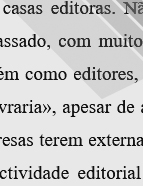

................................
As already mentioned, the publisher profession did not exist until the 19th century. While responsible for book production, the work of the printer or bookseller did not involve assembling a specific catalogue with a particular audience in mind or revising the text and securing translations. Indeed, these tasks are at the very heart of the publisher's work, serving to individualise them and give them a professional identity. Although publishers would sometimes choose titles, intervene in the texts or have them translated, this was never their core activity. They only did so as a means of increasing production. In fact, the figure of the bookseller and the printer would often overlap, and the same agent produced, imported and sold publications. This reality changed towards the late 18th century. The expansion of reading gave rise to an increase in the reading public - and, of course, the need to adopt strategies to build their loyalty, such as fascicles -, the cheapening of book production, the expansion of publishing in national languages and, as a result, the increased importance of translation: all these factors came to define the role of the publisher. In the second half of the 19th century, it may be said with authority that publishers and publishing houses had effectively come into their own. However, in Portugal, some elements of the past were still present, with many printers and booksellers adapting and also working as publishers, while maintaining their former activities and the name "typography" or "bookshop", even though the publisher profession had already become autonomous and production had been outsourced by many of these companies. But the movement was irreversible and the separation between publishing and bookselling continued into the 20th century, mainly from the 1930s onwards; however, some publisher-bookshops remained. (J. L. Lisboa, “Os Editores…” ["The Publishers"], 2015, pp. 15-22; J. L. Lisboa e D. Melo, “Passos Decisivos…” ["Decisive Steps"], 2015, pp. 33-34; N. Medeiros, Edição e Editores [Publishing and Publishers]…, 2010, p. 101.)
Despite the increased number of readers, books continued to be the object of consumption of an elite in the early 19th century (except for some more popular genres, such as cordel literature). Instead, newspapers and the theatre became the main vehicles for promoting intellectuals to the public and disseminating their work. Therefore, the writer was not professionalised as the author of a book, but rather as someone making a living from other work, nor did he manage to get published abroad, with a few exceptions, such as Garrett and Herculano. Hence, the Portuguese market remained inferior and peripheral, and its production was concentrated in just three cities: Lisbon, Porto and Coimbra. (M. L. Santos, Intelectuais...[Intellectuals...], 1985, pp. 229 et seq.) For financial reasons (difficulty in selling them at a higher price), the editions were of poor quality; luxury books, with illustrations and a good finish (in terms of paper and binding, printed with good quality characters) only became more common from the 1870s onwards. (A. Anselmo, Estudos de História do Livro, [History of Book Studies] 1997, p. 128.)
